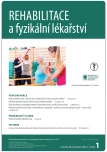Režimové opatrenia zlepšujú kvalitu života po infarkte myokardu
Authors:
Labudová M.; Šimonová M.; Zambojová I.; Ďurinová E.; Macháčková B.
Authors‘ workplace:
Fakulta zdravotníckych vied, Piešťany, Univerzita sv. Cyrila a Metoda v Trnave, Slovenská republika
Published in:
Rehabil. fyz. Lék., 28, 2021, No. 1, pp. 12-16.
Category:
Original Papers
doi:
https://doi.org/10.48095/ccrhfl20212
Overview
Aim: The aim of the work was to point out the importance of physical activity and adherence to regimen measures in relation to the quality of life in patients after myocardial infarction (MI). Methodology: The study group consisted of 77 patients with an acute MI (66.2% men and 33.8% women) with a mean age of 64.8 years (from 43 to 86 years). The data collection was performed using the anonymous standardised MacNew QLMI questionnaire, aimed at assessing quality of life, supplemented by demographic issues as well as questions aimed at changing and adherence to lifestyle. Results: Despite the fact that almost all probands declared that they were informed about the need for regimen measures after overcoming an MI, only a part of the probands sufficiently control them (55.8 %) and an even smaller part applies them in practice (35.1 %). Younger patients are more likely to follow the recommendations, women more often than men (with statistical significance of differences). Adherence to regimen measures is directly related to the quality of life of patients after a heart attack. Conclusion: Lifestyle change after an MI (as part of secondary prevention) improves not only the prognosis but also the quality of life. Less than satisfactory application in practice may have subjective causes (absence of motivation in the patient), as well as insufficiently intensive education by nursing staff.
Keywords:
myocardial infarction – Physical activity – regime measures – Quality of life
Sources
1. Aschermann M. Kardiologie. Praha: Galén 2004 : 1540. ISBN 80-7262-290-0.
2. Chaloupka V. Rehabilitace nemocných po infarktu myokardu. Interní Med 2004; 6(2): 74–78.
3. Vítovec J, Špinarová L, Špinar J. Sekundární prevence po infarktu myokardu – režimové a farmakologické postupy. Interní Med 2011; 13(5): 202–204.
4. Beňačka J, Mašán J. Kardiovaskulárna rehabilitácia. Trnava: Univ. sv. Cyrila a Metoda v Trnave 2014 : 138. ISBN 978-80-8105-538-6.
5. Gurková E. Hodnocení kvality života. Pro klinickou praxi a ošetřovatelský výzkum. 1. vyd. Praha: Grada Publishing 2011 : 224. ISBN 978-80-247-3625-9.
6. Heřmanová E. Koncepty, teorie a měření kvality života. 1.vyd. Praha: Slon 2012 : 239. ISBN 978-80-7419-106-0.
7. Thompson DR, Yu CM. Quality of life in patients with coronary heart disease – I: assessment tools. Health Qual Life Outcomes 2003; 1 : 42. doi: 10.1186/ 1477-7525-1-42.
8. Ištoňová M, Zeman M, Judičáková M. Edukácia v rehabilitačnej starostlivosti pacienta s infarktom myokardu. Kvalitná ošetrovateľská starostlivosť – základný predpoklad kvality života pacientov. Zborník z 3. Slovenského chirurgického dňa v Košiciach. Prešov: Prešovská univerzita v Prešove 2010: 23–30.
9. Kordulová P. Vzdělávání sester v akutní kardiologii. Interv Akut Kardiol 2017; 16(1): 32–34.
10. Novotná Z, Hudáková A, Šimová Z et al. Vybrané kapitoly z ošetrovateľstva vo vnútornom lekárstve I. Prešov: Prešovská univerzita v Prešove 2012 : 201. ISBN 978-80-555 - 0597-8.
11. Junehag L, Asplund K, Svedlund M. Perceptions of illness, lifestyle and support after an acute myocardial infarction. Scand J Caring Sci 2014; 28(2): 289–296. doi: 10.1111/ scs.12058.
12. Moryś JM, Bellwon J, Höfer S et al. Quality of life in patients with coronary heart disease after myocardial infarction and with ischemic heart failure. Arch Med Sci 2016; 12(2): 326–333. doi: 10.5114/ aoms.2014.47881.
Labels
Physiotherapist, university degree Rehabilitation Sports medicineArticle was published in
Rehabilitation & Physical Medicine

2021 Issue 1
- Hope Awakens with Early Diagnosis of Parkinson's Disease Based on Skin Odor
- Deep stimulation of the globus pallidus improved clinical symptoms in a patient with refractory parkinsonism and genetic mutation
Most read in this issue
- Syndróm mediálnej tibiálnej hrany
- Možnosti využití distanční terapie a telerehabilitace v ergoterapii u pacientů po získaném poškození mozku – pilotní studie
- Může pravidelná chůze u seniorů vést ke zlepšení jejich celkové posturální stability?
- Režimové opatrenia zlepšujú kvalitu života po infarkte myokardu
